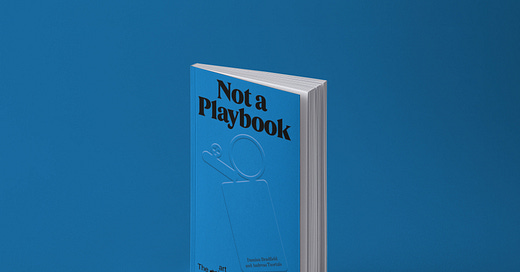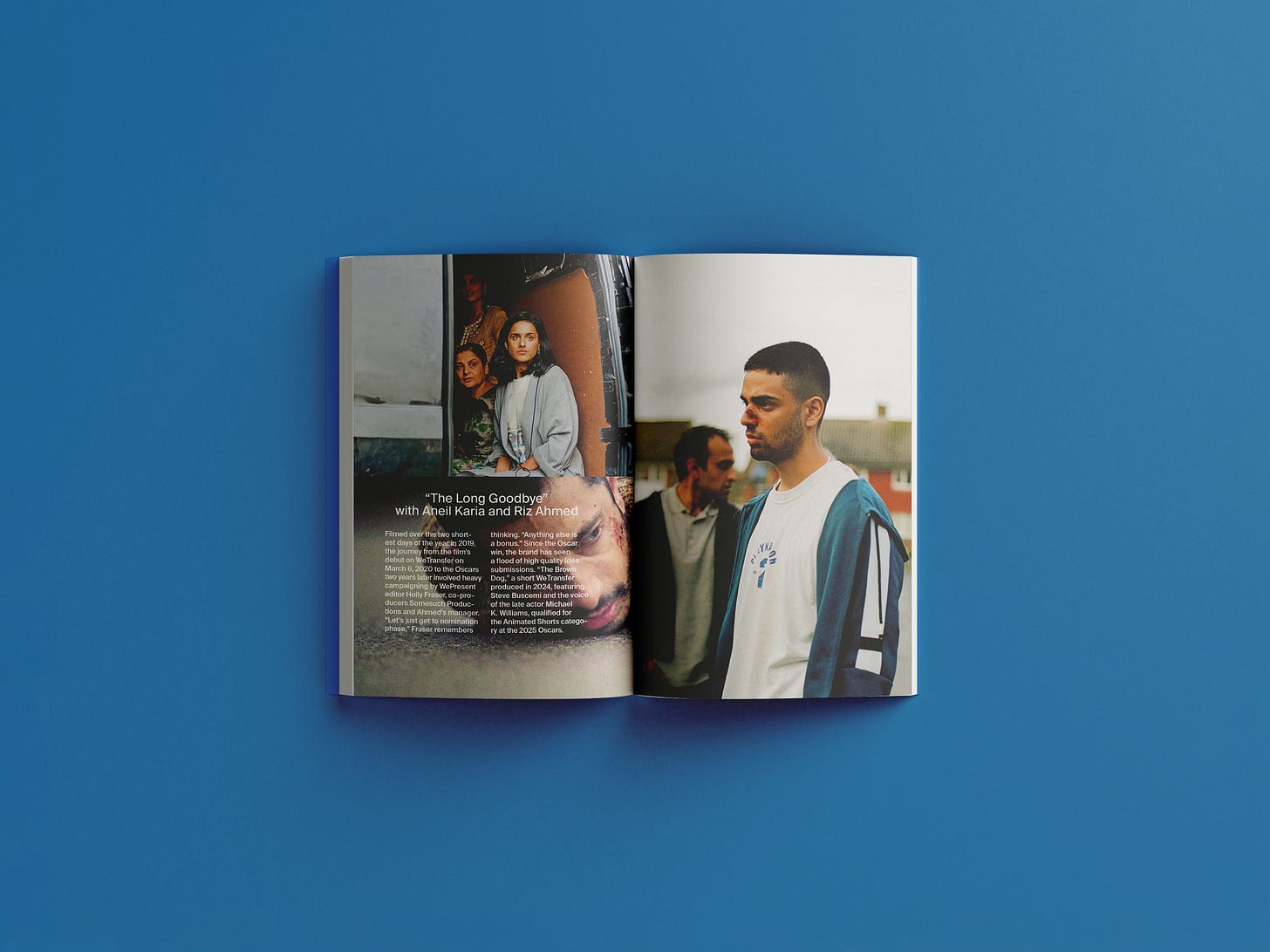Note: This is the first in a short series about the book I co-authored with WeTransfer co-founder Damian Bradfield on building a more soulful brand. Not a Playbook: The science Art of Building a Brand is available for pre-order here.
There’s a corner café you should visit when you’re in Amsterdam. It sits at the edge of a small square and its outside tables also spill over a small road, finally nestling up against the houseboats on the Prinsengracht.
The Cafe Marcella is where I have morning meetings with coffee that’s decidely not third-wave, and afternoon beers that stretch into the evening (there’s a break in between, typically). And it’s where friend-of-the-letter and co-founder of WeTransfer Damian Bradfield told me about a clever idea for a book.
WeTransfer, you might not be aware, is not just a successful file sharing business — with 80 million monthly users across 190 countries — but a patron of the arts funding thousands of creative projects since its founding in 2009.
They’ve created songs, films, and stories with some of the biggest artists in the world (Marina Abramović, Little Simz, Björk, Riz Ahmed …) often meeting them in their liminal spaces, far from the mainstream work that had made them famous.
They’ve stepped in with budget and a platform when no one else would, and imposed few brand guidelines and copyright demands.
They are willing and able patrons, and their approach has won them accolades in the advertising world, and an Academy Award.
But very few people know about it.
“Artists have been coming up to me and saying that we need to talk about this more,” he told me. “They actually want it out there, because they want more brands to work with them that way.”
So he proposed we write a book together, called “How to Win an Oscar”. The title was purposefully tongue-in-cheek, a swipe at the reams of hack-y brand growth advice contaminating the Internet and beyond.
We imagined the book would look like John Cleese’s slim, attractive volume, “On Creativity”. Maybe we’d even throw in a “F*ck” somewhere on the cover, like every other airport book you see these days.
The intent was to showcase what few knew about WeTransfer: a file sharing service that had evolved into a patron and champion of the artistic and creative community that used it.
After a few weeks of interviews with Damian, and employees past and present, things suddenly changed.
WeTransfer was acquired by Bending Spoons, a technology platform from Milan with a track record of buying established companies and streamlining them in an effort to boost growth. They fire a lot of people as part of that process. Within a few short weeks, they announced at 75 percent cut in the workforce.
The cuts included many of those that had helped build and nurture the beloved brand. So we were left in a bit of a lurch: what would this book be in the end? A manifesto? A eulogy?
It would be neither.
It would be Not a Playbook, but a story that documented the behaviors and choices that enabled this brand to build an emotional connection with their audience.
We thought anyone building a company, or shaping brand and marketing at bigger companies, might be able to borrow some things from the WeTransfer story.
I certainly have since writing it.
Brand narratives aren’t clean
Initial drafts of the book were written in “the royal We”. That was me channeling Damian’s voice. But it felt boastful and preachy. We realized after a couple of rounds that we didn’t want it to sound like I was transcribing a decree. The better approach would be a type of investigation into the choices the company made in building the brand over the last 15 years, and providing context on the competitive landscape that confronted them. We switched the writing voice from “We” to “I”, and, together with cultural strategist Alice Sweitzer, began the often difficult journey of reporting on, and sorting through, the behaviors and moments that had come together to produce such a unique brand. There was sometimes tension between myself and Damian on what topics to include, and the degree to which I talked about failed collaborations, or failings on their marketing side. But far more often than not, the outsider’s perspective helped to put into context some of the bolder, more unconventional strategies they deployed — and how they looked in the rearview mirror (mostly confident, but sometimes foolhardy as well).
A brand is the people shaping it
Brand names might be built by predictive machine, but long-term brands aren’t. Damian had a eye-opening line at the beginning of our conversations, about how a brand is really just about the type of people working there as they build it. The success of the WeTransfer story came down to the type of people who believed a tech company’s mission was both to provide useful tools and set forth beautiful, powerful creative projects into the world. Those people helped infuse the brand with its personality and its behaviors. Those behaviors led to actions: like giving unsold ad inventory on the WeTransfer home page to promote artists and nonprofits; or ignoring VC calls to ask for more data from its users. They also led to a consistent, coherent brand story around celebrating and promoting artistry — highlighted by the company’s arts platform, WePresent. The best brands have a vision that people working there can easily identify and make their own.
Speaking of artists, they’re good models
When it came to structuring the book, we quickly threw out a chronological approach. The different eras of WeTransfer each had their stories to convey, but doing so in a linear way felt yawn-inducing. Inspired both by the artists WeTransfer worked with, and their creative user base, I started looking at artist qualities, and which ones might be applied to brands. Intention was the first that came to mind. Artists are incredibly intentional in the work they produce. WeTransfer was the same in the way they designed and built their product. The others — trust, faith, and instinct — came soon after. Damian often brought up artists like John Malkovich when he talked about how he thought WeTransfer should behave. The best brands, like the best artists, have distinct personalities that manage to be coherent, even when they surprise.
There is no playbook
Each book subject presents itself differently. There is no right way to write a book. There is a time-tested format, yes, but that doesn’t mean you shouldn’t take the opportunity to subvert it, or embellish it. A breakthrough came for us when Kris Pyda and Kris Latocha (A Pole in Berlin, a Pole in Brooklyn) joined the project and lent their design savvy and craft to turning words on pages into something tangible, fun, and intriguing. Kris experimented with broken type in the text and included white space with story “takeaways” in type twice the size of the regular text. We thought about them as a parallel narrative. What if people just picked up the book and idly flipped through it in a shop? Read together, would they make sense? Kris also took a back-burner idea about showcasing the brand’s creative work and brought it to life through spreads, like the one above. I haven’t written about the audio book yet. Maybe I’ll save more detail for another post, but it’s not like any ones I’ve heard. Credit there goes to (new) friend-of-the-letter Will Horrocks, who took a recording of Damian and I dutifully reading the book into a microphone and embellished it with a mix of interviews, artist voices and sound design that is more Experience than audio book. The best brands break their own conventions but manage to still take their audience with them. Let’s hope the same goes for books written about them.








Ready to read this Book!!! Cheers form CDMX...
A n d r é s .
It looks stunning- congratulations!